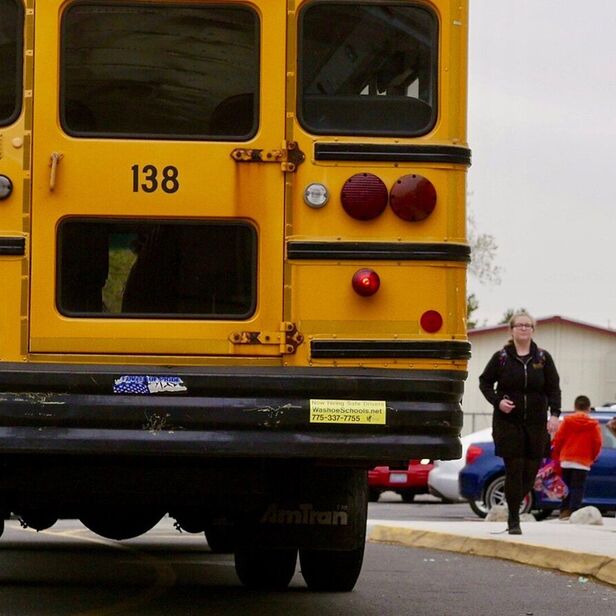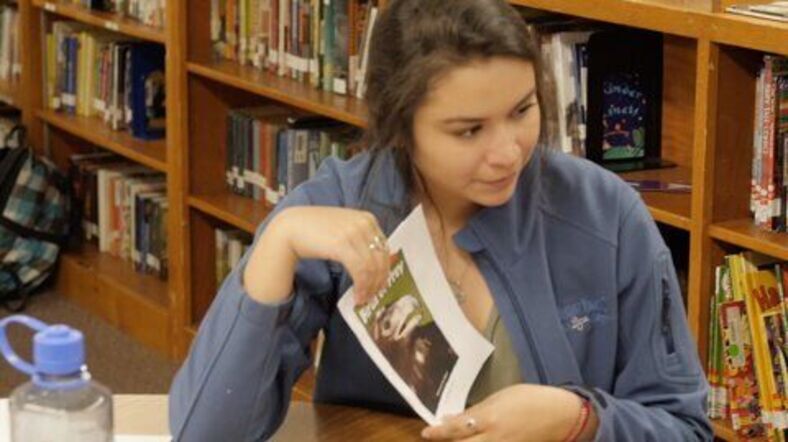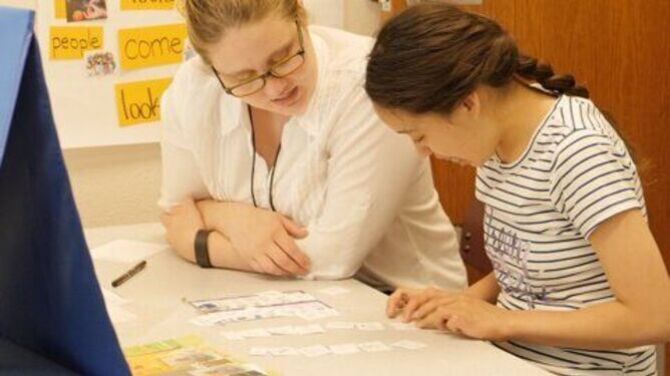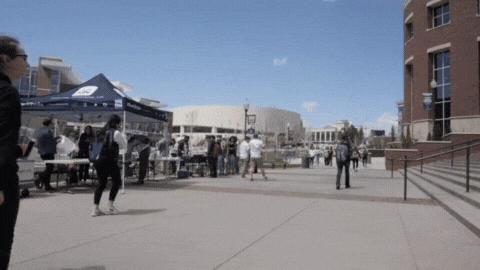Building Blocks: Modeling
Important teaching practices are modeled for teacher-candidates and broken down into component parts so teacher-candidates understand “why” they work.

Opportunities for practice are intentionally woven throughout a teacher-candidate’s experience, and increase in complexity over time.
Practice is essential to learning, but not all practice is equivalent. Practice that is purposeful and deliberate is superior to practice that relies on mere experience to drive improvement.
Put simply, the quality of practice is as important — perhaps even more important — than the quantity.*
*See Practice with Purpose for more about strengthening the quality of teacher-candidates' clinical opportunities.
For decades (if not longer), schools of education have been criticized for emphasizing theory at the expense of practice. Yet our 18 program visits suggest this critique is outdated. Nearly every program we visited proved eager to provide future teachers with meaningful, practice-based experiences.
But how exactly should programs do that? The model of some period of coursework, followed by a student-teaching experience of varying duration, is not the way forward. Nor do we think requiring teacher-candidates to spend more time in the field will (on its own) suffice.
Instead, we believe practice-based experiences should be integrated throughout the design of a teacher-preparation program so that teacher-candidates begin practicing almost from the moment they start their preparation. Theory and practice should be seen as interrelated concepts, rather than separate and sequential. And practice experiences should vary depending on the goal.*
*See the Define Specific Goals section of Practice with Purpose for more on the relationship between practice and goals.
We found a particular compelling example of this type of purposeful practice in the Integrated Elementary Teaching Program (IETP) at the University of Nevada, Reno.






Ashley Krebs, a senior in the IETP program participating in a literacy clinic, sat at a small table next to a middle-school girl. Krebs was tutoring this girl on the different sounds an “i” can make.
Nine. Ribbon. Swim. Fire. Bride.
One by one, the student sounded out the words, deciding whether the “i” sounded more like the one in “kite” – a long vowel – or the one in “pig,” a short vowel.
“This is a ‘ribbon’,” Krebs said, touching the picture of a ribbon that had the word overlaid above.
“Ribbon,” the student repeated.
“So we go, ribbon, -ibbon. Is ribbon like pig or kite?” asked Krebs.
“Riiiiibbon,” the student said, drawing out the vowel sound. Then, definitively, “Pig.”
Krebs was in the final weeks of Lit III, the last course in a three-course literacy sequence completed by all teacher-candidates in the program.* The course content would look familiar to anyone with passing knowledge of literacy instruction, but what differentiates this sequence from others like it are the opportunities for candidates to practice at every step.
*Here's an overview of University of Nevada, Reno's undergraduate literacy program, including Lit I, II and III.
Diane Barone, a foundation professor of literacy, views this sequencing as vital to helping teacher-candidates bridge theory and practice. “We’ve taken that distance away, and they’re immediately practicing, and then we’re providing feedback and scaffolding,” she said
Diane Barone, foundation professor of literacy, explains how University of Nevada, Reno's literacy sequence marries theory and practice.
The curriculum for University of Nevada, Reno’s literacy sequence is “spiraled.” Concepts are introduced in the introductory course (Lit I) and then returned to in greater depth and complexity over the remaining two courses (Lit II and Lit III) — an approach cognitive scientists refer to as interleaving.* The complexity of the practice builds sequentially over time alongside the rigor of coursework.**
*See Question #2 in The Science of Learning for more on how interleaving can help students learn and retain new information.
**Under "Push Beyond Comfort" in Practice with Purpose, we discuss how teacher-preparation programs can push novices just beyond their current abilities in order to help them improve.
For example, Lit I focuses on beginning readers, and introduces concepts such as phonemic awareness, phonics, early writing and reading development. According to Sara Kersten, who teaches the course, teacher-candidates go through a cycle each week: reading research and theory; discussing that research in class and then applying it in their practice session; and concluding with a written analysis of the session.
Kersten believes it’s important for teacher-candidates at this stage to build empathy for students — and for teacher-candidates to get comfortable with making mistakes.
Teacher-candidates need to understand that what’s automatic for them isn’t necessarily automatic for their students. University of Nevada, Reno Professor Sara Kersten explains why.
By design, the practice sessions in Lit I are not complex. The goal instead is to get teacher-candidates familiar with working one-on-one with students in the early elementary grades.
But the complexity of practice increases as teacher-candidates progress on to Literacy II, which focuses on the comprehension, fluency, and vocabulary of 3rd to 8th grade students. Teacher-candidates now practice by teaching small groups of students at these grade levels.
For Dianna Townsend, who teaches Literacy II, it’s important that teacher-candidates don’t learn research and methods in a vacuum. Instead, they need to see how certain strategies play out with real students.
“We can play videos of kids, we can practice fluency activities in the class, but as soon as they get with actual students and try to measure fluency or get a handle on fluency, they see how dynamic and complicated fluency actually is,” Townsend said. Teacher-candidates need to learn this by “watching a student, working with a student, responding to a student, and then reflecting on their own instruction and how the student responded.”
Literacy Professor Dianna Townsend explains how practice opportunities in the literacy sequence are customized to the needs of the particular K-12 students with whom teacher-candidates are working.
For their part, teacher-candidates crave these practice opportunities. As Ashley Krebs, the IETP senior, told us, getting to practice “just prepares all of us … to feel comfortable with what we’re doing and to experiment.”
Many teacher-candidates at University of Nevada, Reno agree.
Teacher-candidates talk about the value they’ve derived from the practice opportunities embedded within the literacy sequence.
By the time teacher-candidates reach the Literacy III course, the focus of the practice shifts to an even-more complex task: supporting struggling readers. During this course, teacher-candidates are paired with a single student with whom they’ll work all semester in a clinic setting, assessing the student’s reading ability and designing lesson plans to address the student’s greatest learning needs.*
*View an example Lit III syllabus.
Rachel Salas, who teaches Lit III, emphasizes that teacher-candidates need to self-monitor their own practice, and be confident enough to explain their instructional choices to others – including parents.
A simple read-aloud with K-12 students can be an 'Aha!' moment for many teacher-candidates. Professor Rachel Salas explains why.
The progression of practice in University of Nevada, Reno’s spiraled literacy courses aligns with many principles of learning science. Practice is deliberately sequenced, spaced out, and designed to foster mental models in teacher-candidates that will allow them to self-monitor and improve over time.
Learn more about the role of mental models in developing expertise on pages 12-13 of Practice with Purpose. Perhaps most importantly, practice is designed to focus on what students are learning, rather than what teachers are doing.
This is hard to do — even within University of Nevada, Reno. Dianna Townsend, the Literacy II instructor, also teaches in the secondary education program, which does not have embedded, sequenced field experiences involving practice. She said she sees a definite difference between elementary candidates and secondary candidates, in part because of the latter’s lack of practice opportunities with K-12 students.
“Our secondary candidates focus more on content materials, lesson planning, their own presence and instruction as a teacher,” Townsend said. “I think our elementary candidates come in wanting to focus a lot on materials and instruction, and I think they leave here focused on kids.”
We suspect that, given time, the type of practice-based education embedded in University of Nevada, Reno’s literacy sequence will spread to other programs. In fact, University of Nevada, Reno Dean Kenneth Coll (a founding member of Deans for Impact), believes that practice needs to be a central force driving teacher education.
Dean Ken Coll talks about the power of weaving practice opportunities throughout a teacher-preparation experience.
If there was one “universal truth” that emerged from our 18 program visits, it’s that teacher-candidates everywhere are desperate to practice. At every program we visited, teacher-candidates expressed a strong desire to spend more time in the classroom.
Perhaps because of this, many education advocates and policymakers have started to push policies that mandate that programs provide longer clinical experiences. While we support the general goal, we think a little caution is in order. Again, the quality of practice is as important as the quantity. There are many ways in which programs may provide meaningful practice without, say, requiring teacher-candidates to undergo a yearlong residency:
Of course, the more traditional model of student teaching is important for practice too. But our conversations with teacher-candidates from numerous programs suggest there is room for improvement.
At one program we visited, for example, the teacher-candidates we observed in K-12 classrooms spent most of their time watching the cooperating teacher with little guidance on what to look for (see our Modeling Building Block for why this is less than ideal). One teacher-candidate at this program told us that she’d been taught various strategies for teaching English-language learners, but had very few opportunities to practice implementing them. Nor did this candidate receive actionable feedback on her performance (see Feedback Building Block for why this is less than ideal as well).
At another program, candidates’ first experience working directly with K-12 students occurred in their student-teaching placement when they were asked to take on the complex task of whole-class instruction. Not surprisingly, candidates at this program felt overwhelmed by the enormity of the challenge. We couldn’t help but be struck by the contrast to the confidence of candidates in University of Nevada, Reno’s IETP program.
Whether described as “braiding” or “spiraling” or “interleaving” practice, we believe teacher-education programs can better prepare future teachers by integrating practice and theory throughout their programs. Leaders within teacher-preparation programs that want to do this might start by asking the following questions:
Important teaching practices are modeled for teacher-candidates and broken down into component parts so teacher-candidates understand “why” they work.
Teacher-candidates receive specific, timely, and actionable feedback – based on a shared vision of effective teaching – across their experiences.
Teacher-candidates receive specific, timely, and actionable feedback – based on a shared vision of effective teaching – across their experiences.
Programs carefully design the trajectory of preparation to create a coherent experience for every teacher-candidate they prepare.
Sign up for our newsletter and follow us on social media to get the latest news.